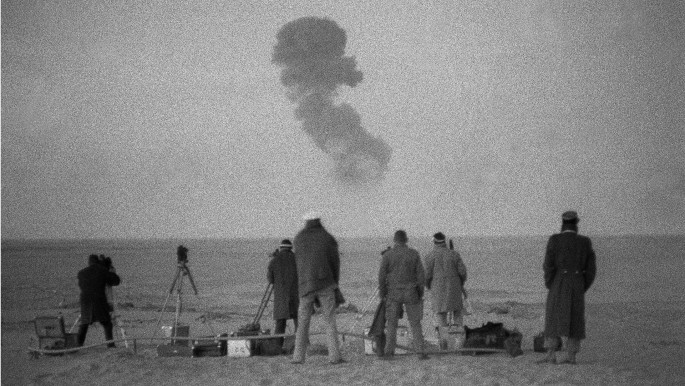France faces up to shame of Algerian nuclear tests
On 13 February 1960, France detonated a nuclear bomb 60km from the Algerian oasis town of Reggane. Its mushroom cloud rose miles into the air for all to see. The earth around the blast site remains scorched to this day.
More than half a century later, Algeria's former colonial master has finally admitted the terrible effects the test - and many others like it - had on the health of witnesses to the blast, and those who lived in its shadow.
Algeria's prime minister Abdelmalek Sellal is to meet his French counterpart, Manuel Valls, in Algiers early next year to discuss compensation for tens of thousands of Algerians said to have suffered from the effects of radiation around Reggane and other parts of southern Adrar province.
The 13 February test detonated "Gerboise Bleue", or Blue Desert Rat, a device with three times the explosive power of the bomb that destroyed Nagasaki in the Second World War.
It was the first of four tests by France over the next few months, all of which were above ground and all of which were dismissed as posing any threat to those living nearby.
French authorities at the time said the radioactive fallout from the bomb was limited. But documents recently declassified by the French government, in response to appeals from French veterans, indicate the fallout was much more extensive and much more harmful than suggested.
In 1961, the tests were moved to an underground site named Ain Icker, also in Algeria's Sahara region. Nine underground tests were conducted there between 1961 and 1966, with a significant radiation leak occurring during at least one of those tests.
Although Algeria won its independence in 1962, under the Evian accords that ended the Algerian war, France retained control of key military sites in Algeria, such as Ain Icker, until 1967.
 |
|
| The tests were observed by scientists from a distance, but not everyone in the area had protective equipment [Getty] |
The quest for truth
The compensation agreement is still far from agreed, however.
French authorities have stipulated that the victims or their families present evidence to prove their health was damaged by the tests.
There is disagreement over the number of victims and the seriousness of the radiation's effects. According to initial figures published by French official Rino Parillo, an eyewitness to the tests, some 42,000 Algerians were affected. Some of them were even used as test subjects to monitor the effect of nuclear weapons.
The French Ministry of Defence has released an official estimate of 27,000 victims, which includes all the French troops and personnel of the French nuclear programme, and the population of the regions of Reggane and Tammanrasset in southern Algeria.
However, Kathem al-Aboudi, a professor of nuclear physics at Oran university, said he believed the estimates of the number of victims should include those who were in nearby desert areas extending to the Algerian-Libyan border and the southern borders.
| Watch archive footage of the detonation of 'Gerboise Bleue' |
They should also include those among the victims' children and grandchildren who showed symptoms of diseases related to radiation such as cancer.
A serious but often overlooked aspect of the case, in Aboudi's view, is that the French authorities refused to provide radiation maps or surveys to the Algerian state or to the military engineering units to whom the nuclear bases were handed over.
"Such maps could have helped in locating the dangerously irradiated areas. Had the French identified the locations accurately and clearly it would have become possible to conduct a comprehensive radiation survey, to discover the sites contaminated by nuclear waste in the region, in Reggane and Ain Ickar in Adrar in the desert in the south," Aboudi said.
It is impossible to remove all of the radioactive material, he said, and any clean up would inevitably be expensive and labour intensive. "Who should bear all this expense?" he asked.
A huge problem, a massive undertaking
| There has been a sharp increase in cancers and genetic disorders, which has affected more than one generation of the victims' children. |
Aboudi said that it would be difficult to bring life back to the Hammudia region in Reggane and the surrounding area, because it was a region of open desert and the tests spread radioactive material over an extensive area.
"There was no monitoring or follow up", he said. "There will continue to be areas off-limits because of the possibility people will be affected by radiation."
He said the areas in which the tests were conducted were "extensive".
"This makes defining the area affected difficult without international cooperation and expertise, especially as the area has been been abandoned for half a century, and there is no systematic evidence to base any assessment of changing levels of radiation over this time."
There has also been a sharp increase in several types of diseases, particularly cancer, which has affected more than one generation of the victims' children, as well as diseases related to genetic disorders, reduced fertility, higher rates of abortion, early delivery and abnormal births, he said.
The damage has not been confined to human beings either, with thousands of animals such as camels sickened, soil fertility damaged and plants and crops in the region affected.
This is an edited translation from our Arabic edition.





 Follow the Middle East's top stories in English at The New Arab on Google News
Follow the Middle East's top stories in English at The New Arab on Google News


